Are you considering switching from BigCommerce to Shopify?
Shopify is noted for its easy-to-use design, customizable options, and advanced capabilities to streamline your business. This blog post will guide you through the BigCommerce to Shopify migration, including key stages to ensure a smooth transition.
Why Shopify May Better Suit Your Ecommerce Needs
User-Friendliness
Shopify offers an intuitive interface, simplifying store management even for non-technical users. From product setup to payment setup, tasks are straightforward.
Customization Options
With a vast array of apps and themes, Shopify allows extensive customization. Whether for SEO tools, marketing automation, or shipping preferences, Shopify's App Store provides solutions.
Scalability
Whether you're a small startup or a large enterprise, Shopify adapts as your business grows. Its robust infrastructure ensures stable performance even during high-traffic periods.
Payment Flexibility
Shopify supports multiple payment gateways, ensuring seamless transactions globally. This versatility in payment options caters to diverse customer preferences.
Support and Community
Benefit from Shopify's strong support network and developer community. Access resources like the Shopify Help Center and forums for prompt assistance and troubleshooting.
Challenges Faced in BigCommerce
Despite being a solid ecommerce platform, BigCommerce poses several challenges that may prompt users to consider switching to Shopify:
- Complex Pricing: BigCommerce's tiered pricing based on sales volume can lead to unexpected costs as businesses grow.
- Limited Customization: Customization options are often seen as restrictive, requiring coding skills or developer expenses.
- App Ecosystem: The app marketplace is less extensive and integrated compared to Shopify, limiting store functionalities.
- SEO Limitations: Some users experience difficulties with SEO customization, impacting search engine rankings.
- Support and Resources: Support and community resources are perceived as less comprehensive than Shopify’s, affecting troubleshooting and business growth.
Steps for Migration for BigCommerce to Shopify
Step 1: Set Up Your Shopify Store
- Sign Up for Shopify: Create a Shopify account and choose a suitable plan.
- Select a Theme: Choose a free or paid theme that matches your brand.
- Customize Your Store: Use Shopify's theme editor to adjust colors, fonts, and layouts.
Step 2: Export Data from BigCommerce
- Export Products: Download product data including descriptions and images as a CSV file.
- Export Customers and Orders: Export customer and order data to maintain continuity.
Step 3: Import Data into Shopify
- Use Shopify's Import Tool: Upload CSV files for products, customers, and orders.
- Verify Data Integrity: Check that all data has transferred accurately.
Step 4: Set Up Essential Apps
- Install Necessary Apps: Explore and install apps from the Shopify App Store for enhanced functionality.
- Configure Settings: Adjust payment, shipping, and tax settings to match your business operations.
Step 5: Design and Test Your Store
- Customize Pages: Design homepage, product pages, and checkout to be user-friendly.
- Test Functionality: Conduct thorough testing to ensure everything works smoothly.
Step 6: Launch Your Shopify Store
- Choose a Domain: Connect your domain or purchase a new one.
- Go Live: Remove password protection and announce your store's launch.
- Monitor and Optimize: Continuously monitor performance and optimize based on analytics and customer feedback.
Migrating from BigCommerce to Shopify can greatly improve your ecommerce operations. Follow this guide to achieve a seamless transition and leverage Shopify's robust platform to its fullest potential. Establish Shopify as the cornerstone of your online business and witness its growth.
Source: BigCommerce to Shopify Migration






Comments